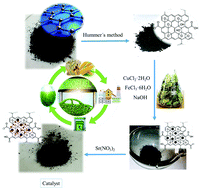In this work, we demonstrated a magnetic-cored high surface area basic nanocomposite catalyst for the sustainable synthesis of biodiesel. Initially, in situ synthesized magnetic CuFe2O4 NPs were impregnated into the surface of graphene oxide (GO) using pistachio leaf extract and subsequently strontium oxide (SrO) was decorated over it. The physicochemical features of the material were analyzed by Fourier transformed infrared spectroscopy (FT-IR), scanning electron microscopy (SEM), energy dispersive X-ray spectroscopy (EDX), elemental mapping, vibrating sample magnetometry (VSM), X-ray diffraction (XRD), and thermogravimetric analysis (TGA). The prepared catalysts were investigated in the transesterification of waste corn oil and rapeseed oil to their methyl esters for the production of biodiesel. Response surface methodology (RSM) was used to standardize the different reaction constraints, such as the methanol/oil molar ratio, catalyst loading, and time involved using a Box–Behnken design. The catalyst was easily recycled after magnetic isolation with almost consistent reactivity.

